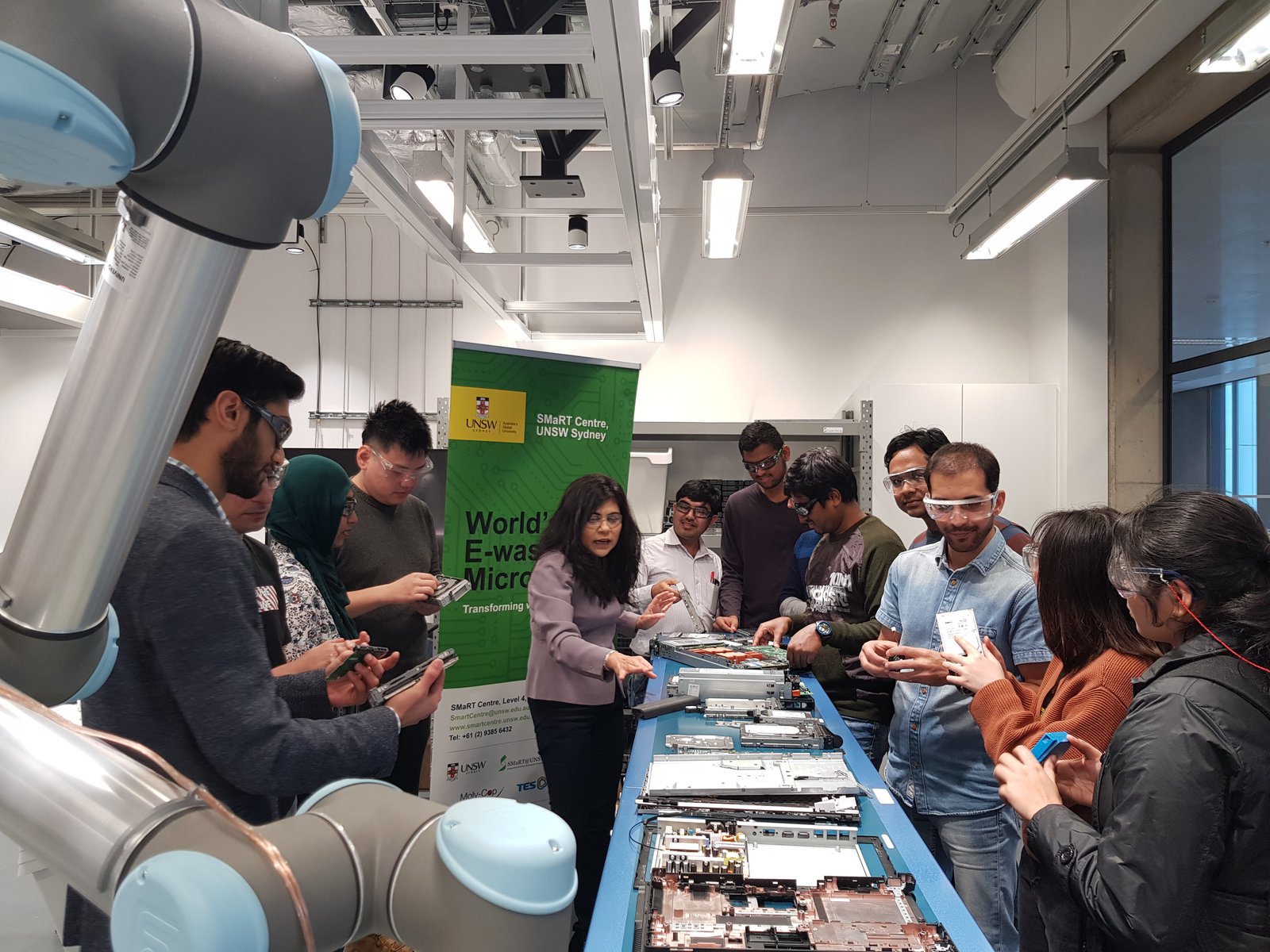Latest news
Read the latest news from the Centre for Sustainable Materials Research and Technology

The Australian Museum has published an "in conversation" feature story about UNSW SMaRT Centre and its Director's efforts to shift the mindset of the nation to see unwanted materials not as waste but as a valuable resource.
The 2022 winner of the Eureka Prize for Promoting Understanding of Science, the ATSE Clunies Ross Innovation Award and the 2022 NSW Australian of the Year, Prof Veena tells the museum recovering critical and valuable materials from waste has a big role to play in electrifying the world as we move towards renewable energies and reducing our carbon footprint.
Do a virtual tour of the museum's SMaRT Centre display
You’re a widely respected voice in the field of recycling science. What initially attracted you to this space?
I grew up Mumbai, which is such a fabulous city with so much going on. As a child, it was about understanding, first and foremost, how people actually made a living. It always impressed me that people would do this by fixing shoes, clothes and all kinds of electronic stuff that we had at home. To me, the creation of all these products out of things that were supposedly broken was really fascinating. I see my work not just as science and engineering, but as wider social reform.
The science we are developing, called ‘microrecycling science’, reveals what happens at the micro level (and below) when materials react with each other. It’s not just about the metals, glass or plastics — it’s about each individual material, component and part. They are all so intricately connected, and that needs to be recognised so they can be reformed into high value materials that can be used again. Consider a magnet that contains a rare earth element like neodymium. How do we isolate that element to recycle it? It comes back to understanding microrecycling science. If somebody gave me a brand-new machine that can crush these magnets down to a fine powder, that is not going to help me — we need science to show us a way to reform the material.
What have been some of the most significant outcomes of your community and industry engagement to date?
It’s essential that society strives to develop a circular economy whereby we keep materials in use for as long as possible. Further, we must establish new business supply chains that will better manage waste as a resource and create new jobs, while also delivering other economic, social and environmental benefits. Various technologies and capabilities that reform much of this unwanted material into new products and manufacturing feedstock are already available right here in Australia. Together, these reduce both the need for landfill, and the mining and production of ‘virgin’ materials.
The community and industry are keen for change that will deliver more sustainable outcomes. Solutions available such as those identified by UNSW researchers at the Sustainable Materials Research and Technology (SMaRT) Centre, which I lead, are now recognised as world-leading, and have attracted support from many industrial partners. These include our Green SteelTM Polymer Injection Technology and our various MICROfactorieTM Technologies, which are used to transform different wastes into value-added products such as high-grade filaments for 3D printing and green ceramics for the built environment.
What are some of the larger impacts you hope to see from your work as a science communicator in the future?
In relation to net zero, recovering critical and valuable materials from waste has a big role to play in electrifying the world as we move towards renewable energies and reducing our carbon footprint. Many of the commodities and critical materials needed for this electrification are being subject to record prices and supply constraint issues. Through innovative manufacturing practices, New South Wales can play a leading role when it comes to the growth in the components needed for electric vehicles, wind turbines, domestic solar systems and batteries.
 Innovative supply chains based on new technologies, which align sectors by using waste as a feedstock for manufacturing, are needed to create a true circular economy and enhance sovereign capability. Businesses and organisations generally rely on traditional supply chains, where reformed materials are usually not part of the chain. We need to ensure that alternative solutions to current common supply chain practices, adopt new and local supply chains that incorporate resources made from our own waste. The future of global manufacturing lies in small-scale, decentralised technologies that will enable communities to produce many of the products, materials and resources they need locally, by largely using inputs that are unwanted or thought of as waste. The severe impact of COVID-19 on global supply chains presents a significant case for this transition.
Innovative supply chains based on new technologies, which align sectors by using waste as a feedstock for manufacturing, are needed to create a true circular economy and enhance sovereign capability. Businesses and organisations generally rely on traditional supply chains, where reformed materials are usually not part of the chain. We need to ensure that alternative solutions to current common supply chain practices, adopt new and local supply chains that incorporate resources made from our own waste. The future of global manufacturing lies in small-scale, decentralised technologies that will enable communities to produce many of the products, materials and resources they need locally, by largely using inputs that are unwanted or thought of as waste. The severe impact of COVID-19 on global supply chains presents a significant case for this transition.
Technologies such as MICROfactories™ can enable the lateral integration of different industrial sectors by recovering and reforming so-called ‘waste materials’, to create new and localised supply chains, materials and products, offering a range of economic and environmental benefits. The science and technology already available to us now make it possible for a complicated waste stream to produce value-added materials, which can then feed into different industrial supply chains for manufacturing products.
This emerging model will profoundly disrupt today’s centralised, vertically integrated model of production, where — for instance — a single material or part available only from an overseas supplier can interfere with the manufacturing process. Through our Green Steel technology, millions of tyres have already been diverted from landfill, partially replacing coke in electric arc furnace steelmaking. This is just one example of sectors not normally aligned becoming so by using waste as a resource. Other materials, such as glass, textiles, biowaste and e-waste are being transformed into feedstocks and products like metals, industrial grade ceramics and plastic filaments, which are then used in 3D printing. Market forces alone are extremely unlikely to ensure the uptake of these practices to a point where sustained benefit will be achieved.
What does winning a Eureka Prize mean to you?
It’s an incredible honour to be awarded the 2022 Eureka Prize for Promoting Understanding of Science, and it’s such a privilege to be able to share the important role science plays in our daily lives, with the wider community. Without science, we would not be able to enjoy most of the things we now take for granted.

Professor Veena Sahajwalla following her acceptance of the 2022 Celestino Eureka Prize for Promoting Understanding of Science.
Science has become much more mainstream than ever before, and its role in seeking solutions to issues like COVID-19 and our pressing waste, sustainability and climate challenges, has created a wider thirst for knowledge and optimism. The team and I at the UNSW Sustainable Materials Research and Technology (SMaRT) Centre are dedicated to collaborating with the community and industry to tackle the challenges we face, to help deliver better social, environmental and economic outcomes.